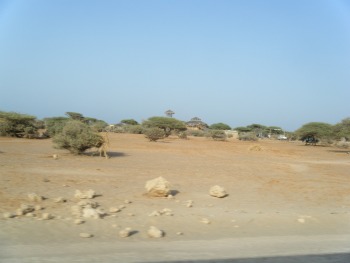 Camp Lemonnier is located on the southwest side of the Djibouti-Ambouli International Airport, between the runway overflow areas and a French military munitions storage facility. Originally, the camp belonged to the artillery of the French 5th Overseas Task Force (5th RIAOM). Murals depicting colonial soldiers, former name of the Marine Troops from which the 5th RIAOM was formed, adorn the walls of the Camp Lemonnier white house in rememberance of the the Camp's historical origins. Following use by the 5th RIAOM, the facility was operated by the Djiboutian Armed Forces.
Camp Lemonnier is located on the southwest side of the Djibouti-Ambouli International Airport, between the runway overflow areas and a French military munitions storage facility. Originally, the camp belonged to the artillery of the French 5th Overseas Task Force (5th RIAOM). Murals depicting colonial soldiers, former name of the Marine Troops from which the 5th RIAOM was formed, adorn the walls of the Camp Lemonnier white house in rememberance of the the Camp's historical origins. Following use by the 5th RIAOM, the facility was operated by the Djiboutian Armed Forces.
The U.S. Government created Combined Joint Task Force-Horn of Africa (CJTF-HOA) to conduct stability operations in the Horn of Africa after September 11, 2001. In November 2002, the CJTF-HOA staff, a Marine-based organization, arrived off the coast of Djibouti onboard USS Mount Whitney (LCC-20). In May 2003, CJTF-HOA transitioned from the Mount Whitney to Camp Lemonnier, moving all headquarters personnel and equipment.
On July 1, 2006, the U.S. Marine Corps turned over responsibility for Camp Lemonnier to the U.S. Navy. U.S. Central Command (USCENTCOM) took over as the component commander while the base fell under the operational command of Commander, Navy Region Southwest Asia (CNRSWA).
In January 2007, the U.S. and Djiboutian governments announced that a lease agreement had been signed to expand Camp Lemonnier from 88 acres to nearly 500 acres. The term of the lease was for five years with options to renew. With the additional land, living conditions for personnel improved with the installation of containerized living units (CLUs) along with concrete sidewalks and gravel roads. This drastically improved quality of life as people moved from tents to CLUs.
On October 1, 2008, Camp Lemonnier was realigned in support of the stand up of U.S. Africa Command (USAFRICOM). Responsibility for CJTF-HOA was transferred from USCENTCOM to USAFRICOM as it assumed authority over the African theater of operations. The base also changed from CNRSWA to Commander, Navy Region Europe, Africa, Southwest Asia (CNEURAFSWA).
In May 2009, Camp Lemonnier welcomed the arrival of the Japanese Maritime Self-Defense Force P-3 Detachment making significant contributions to the anti-piracy mission along with the many coalition ships making Djibouti a frequent place to stop. This led to the stand up of the first Maritime Security Squadron on the African continent in July 2009, providing port security for ships at the Ports of Djibouti and Doraleh.
More than 20 new facilities projects have been constructed on Camp, which have included an aircraft apron, two taxiways, chapel, galley, a second recreation center, water production and distribution center and a wastewater treatment plant. Camp Lemonnier is currently executing construction funded by FY11-FY12 Military Construction (MILCON) appropriations. These projects are expanding the Camp's operational capability and increasing the utility infrastructure. Projects include: a fuel farm, fire station, and an aircraft hanger.
In addition to the MILCON program there are additional maintenance and repair projects for Camp facilities. These include: pool repairs, shade canopies for MWR facilities, and upgrades of utilities. All of these projects increase the Camp's ability to support tenant commands in the Horn of Africa.
Throughout its history, Camp Lemonnier has evolved and adapted to ever-increasing mission demands. There are still many chapters that remain unwritten as the camp positions itself for the challenges of the future.